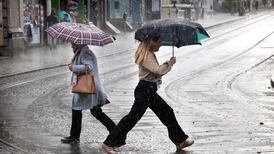A package recently arrived in the post for Jesmond Harding, a teacher from Meath who has been captivated by butterflies since the age of five. It was from the family of his late friend Michael Preston. Beginning in the 1960s, Preston, a solicitor, had amassed a collection of pinned and mounted Irish butterflies, and he bequeathed the lot to Harding.
On opening the package, Harding was astounded. There were Marsh Fritillaries and Dark Green Fritillaries that Preston had found near Prosperous, Co Kildare. Harding hadn’t seen them there since 1995. Pinned to one of the boards was a Gatekeeper – a delicate little auburn butterfly often found on bunches of flowers where the gate and hedge meet. Preston had labelled it “Blackrock, Co Dublin”. Harding could hardly believe it; today, if you’re lucky, the nearest to south Dublin to see a Gatekeeper is along the coast of Wexford.
Do we need to prepare for summers without butterflies? We would be foolish to take comfort from the fact that the last species to go extinct here was back in 1900, when the altitude-loving Small Mountain Ringlet was spotted on Croagh Patrick in Mayo, never to be seen again. Today, many of our butterfly species, such as the Speckled Wood, Large White, Green-veined White, Meadow Brown and Ringlet, are rapidly fading away.
[ Butterfly count continues worrying trend despite warm and dry summerOpens in new window ]
In a few weeks scientists from the National Biodiversity Data Centre will release results from 2022′s butterfly survey. Don’t expect good news.
READ MORE
It’s been a low-key month for butterflies, if the unnerving absence of these fluttering bursts of colour is anything to go by, but let’s see what July brings. There are a few signs of life. On my hillock of nettles beside the house, two Red Admirals have arrived from overseas (some enterprising individuals hitch a lift on Irish fishing boats, apparently). Butterfly expert Bob Aldwell tells me they’ve come in thanks to the large volume of warm air over the past few weeks.
As they bask in the sun, Red Admirals don’t seem bothered if approached; it gives me time to admire their handsome, sharp appearance (think well-tailored aristocrat adorned in velvet). The splash of red catches the eye, but their jet-black body, covered in a thick pelt of hair, does the internal work of harvesting the sun’s warmth to charge their muscles, ready for flight.
They’re powerful in the air and display an athletic prowess akin to the Olympic gymnast Simone Biles flinging herself across the floor without restraint. Red Admirals have an impressive repertoire of aerial movements, switching rapidly from one wing stroke to another. They do this to confuse predators.
Males are so desperate to procreate, they’ll pursue anything that flies, including skylarks and cuckoos. The birds must be baffled by the attention
Rarely have I seen more than three butterflies at once, but historical accounts mention vast quantities flying together.
I call Harding. “Have you ever seen a ‘’cloud’ of butterflies?” I ask. He tells me of a wet spot in the Burren, laden with marsh-marigold and bogbean plants, where he spotted an evening roost of ‘’hundreds’' of male Dark Green Fritillaries a few years ago.
After spending the night together, these males warm up in the morning sun before purposefully flying across the dry limestone, flower-rich grasslands with one thing on their minds: to find a female, pronto. Males are so desperate to procreate, they’ll pursue anything that flies, including skylarks and cuckoos. The birds must be baffled by the attention.
We’d do well to be alarmed by the absence of butterflies. Irish and EU researchers monitor them because they indicate the broader ecological health of our environment; they disappear when our landscape is sick. Scientists must be bored silly listing the reasons they’re struggling. It’s the usual: intensification of agriculture, nitrogen pollution, chemical sprays, drainage of bogs, loss of habitats, invasive non-native species, climate change. The data is all there; what’s missing is action.
[ How to create a butterfly banquet in your gardenOpens in new window ]
Some of the responses are misguided. For instance, Denmark sends Marsh Fritillary caterpillars to northern Germany to help keep numbers up. The generosity of the Danes is to be admired. Still, no quantity of caterpillars will solve the German problem: their habitats are gone, and the caterpillars and butterflies are starving and homeless. The more challenging issues, such as nitrogen and phosphorous pollution, require systemic shifts in managing our land and rivers.
By September, Red Admirals will have stocked up on nectar and departed for Spain, France and north Africa, where they’ll spend the winter. They ascend to high altitudes to catch a lift on the northerly winds, then float southwards towards their warmer destinations.
Our rapidly heating climate means some don’t bother leaving; they’ve been spotted over-wintering in Howth Head instead. Butterflies never fail to tell us something important about the state of our world.
Well, what to do? It starts with the very, very hungry caterpillars, so go online and find out what plants they need to survive, or consider buying Jesmond Harding’s worthwhile book, The Irish Butterfly Book (2021). Engage with Irish farmers who are balancing food production with restoring nature on their land.
Finally and perhaps most critically, the EU’s proposed Nature Restoration Law includes legally binding targets for the restoration of habitats for butterflies; the law has the public support of big corporations such as Danone, Nestlé and Coca-Cola, along with thousands of scientists across Europe, including Prof Jane Stout in Trinity, who knows a thing or two about what works for nature.
We have a short period to sort this out; our butterflies are missing, not gone. Not yet, anyway.














